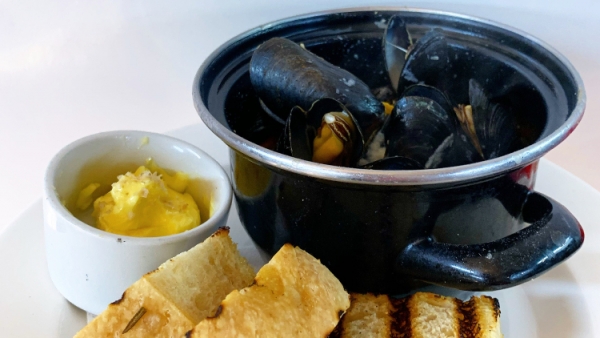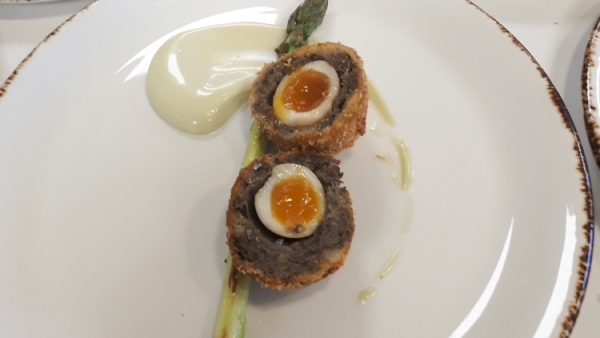What food do pub-goers want to see on menus in 2020?

This year, operators are set to face seaganism, localism, sustainarianism, and it looks like veganism will also see more victory.
As consumers continue to test the waters with infinite diets and preferences, fresh food supplier Bidfresh is advising operators to increase their menu offerings to endorse the complex set of values that are brought to the table when dining out. Even classics such as steak and salmon may well be in for some competition.
Meat feast
Meating demand
Best sellers 2019- Beef feather blade
- Chicken fillets
- Rib-eye steaks
- Lamb rump
- Rump steaks
- Beef steaks
- Chicken fillets
- Beef burgers
- Sausages
- Bacon
- Beef mince
- Pork belly
- Pork loin ribs
- Roasting beef
- Lamb shoulder
Source: Bidfresh’s 2020 Vision: Fresh Food Trends in Hospitality and Foodservice report
According to Bidfresh’s 2020 Vision: Fresh Food Trends in Hospitality and Foodservice, sales of trendier meat cuts such as the Flat iron steak will be a big hit in the casual-dining sector. Chefs are also juicing up their menus with venison, using it in anything from burgers and pies to Scotch eggs and street food.
Tailored burgers for specific menus, using cuts such as a chuck, brisket and bavette, are currently very much in demand.
However, 2020 could see burgers blended with plant-based foods, including the likes of fresh mushrooms, for consumers who still want meat but less of it. Bidfresh chief executive officer Stephen Oswald says: “Bespoke burgers continue to be an important trend, and we’re also expecting many more recipes that feature meat combined with plant ingredients to appear on menus in 2020.
“From jackfruit to halloumi, there’s a huge amount of innovation from chefs in these areas.”
Oswald explains, however, that for those who have cut back on meat, expect a premium product with provenance for the occasional times that they do eat it.
Generally, the origin and production of meat has become a sharper focus among consumers, therefore, operators must keep meat quality and animal welfare assurances in the spotlight.
Countrywide Butchers has worked with RSPCA to advise on its new ‘Five Freedoms’ Animal Welfare policy and will continue to focus on welfare in its sourcing, according to the Bidfresh report.
Veganism marches on
Menu trends for 2020
- Food with values
- Eco-friendly packaging
- Products with a story
- Health: reducing sugar and fat
- Plant-based dishes, including for takeaway
- Meat/plant-based blends
- Seagan dishes
- Healthy snacks
- No waste
- New-wave salads
- Street food influences remain
Source: Bidfresh’s 2020 Vision: Fresh Food Trends in Hospitality and Foodservice report
The consciousness of animal welfare is, of course, on the forefront of the vegan boom and will continue to drive innovation in your menu.
The majority of fruit and vegetable wholesaler Oliver Kay’s fastest growing products in the past year tap into the increasing need by chefs to cater for vegans/flexitarians.
The diet has seen a flourish of innovative products, including vegan bacon jam, silken tofu, vegan potato slider buns, vegan seitan pepperoni and chicken plant-based salt and pepper pieces in the highest climbers.
But as veganism drives the plant-based products forward, the Bidfresh report forecasts seaganism to come into play this year. It is considered a broadly plant-based diet that also includes fresh and seafood. It differs from pescatarianism in that a seagan diet does not include eggs or dairy and focuses largely on eating fish that is sustainably sourced.
Sustainarianism has also been brought to the forefront, in which the impact of environmental and ethical food production is factored into menu choices. Oswald continues: “Eating out is increasingly as much about value as it is cost; not just value for money but the values that an operator brings to the menu.
“These ‘sustainarian’ customers increasingly want to be sure that the food they eat has been produced sustainably and ethically, and they also curate their own food choices very carefully.
“So, while some consumers fully embrace the plant-based trend, others are looking for that ‘seagan’ combination of seafood and plant-based dishes, which is an area where we’re seeing a great deal of menu innovation from customers and have also been building our own online recipe bank.”
Riddled with guilt
As we sit in centre of the first month of the year, the notorious Dry January challenge is ongoing, but what other theme springs to mind after a calorie-overloaded Christmas?
Diet. After the holiday, the guilt kicks in and many consumers are determined to abstain from meat, cheese, chocolate, alcohol – anything scrummy basically – to shed the Christmas belly. So how can you meet this inevitable trend?
Andrew Waddison, owner of AWPR – a PR company that works with pubs in Norfolk – says: “We are too early for traditional salads but we should be pushing lighter options such as the Duck Inn’s gorgeous leek and Norfolk Dapple cheese gratin or mouth-watering textures of beetroot with Rosary goats’ cheese, or the Rose & Crown Snettisham’s glorious take on Norfolk tapas.
“Here in Norfolk, we are blessed with incredible local produce such as Brancaster mussels or Staithe Smokehouse salmon that provide nutrition and vitamins without the gorge factor of rich suet pies or heavy stews.
“The Hunworth Bell bear Holt offer a huge selection of amazing Bar Bites, which are lighter snacks to have with a drink or in tapas style.
“There is always a place for hearty food in the new year but there must always be lighter options to encourage those riddled with the guilt of carrying a few extra festive pounds.”
Keeping it local
The localism trend continues to grow in the UK foodservice market, with operators increasingly keen to feature regional products to tap in to consumer demand for supporting local producers.
Liberation Group executive chef Alice Bowyer says: “Historically, January and February are busy months for us. Across the estate, our menus are famed for good, local produce and our commitment to a field-to-fork ethos resonates well with customers wanting to take a well-earned break after a busy festive season.
“Our allotment menu proves very popular, making a hero of the wonderful produce grown locally. Dishes such as buffalo cauliflower wings, kale and winter squash Caesar salad with crispy chickpeas and tahini dressing; and a wintery pearl barley stew with garlic mushrooms, Jerusalem artichokes and heritage carrots always do really well.”
With caterers particularly increasingly looking for a local story behind a product to help drive margin, it is no surprise that a Cheddar produced by the stalwart cheese maker Barbers 1833 Vintage Reserve, was the British cheese star performer of 2019, according to the Bidfresh report.
Its sales have also been boosted by the trend for vintage cheeses with stronger flavour profiles. Among other Brits continuing to pack a sales punch in the past year were Applewood smoked cheese, Snowdonia Black Bomber and Tunworth British Camembert.
Britain is now making some of the best cheeses in the world, and growth is being driven by consumers willing to pay a premium for a quality, artisan product.
However, to drive sales further in 2020, Bidfresh advises operators to continue focusing on educating customers as to ‘why the premium price?’
Fish is catching on
Here are the top trends according to Bidfresh’s 2020 Vision: Fresh Food Trends in Hospitality and Foodservice report:
Sustainability gains: sales of sustainable fish products through Direct Seafoods increased by 18% as caterers respond to increasing consumer awareness and demand for options that are kinder to the environment, and this looks set to increase further for 2020.
Pubs pushing growth: one of the biggest growth areas in fish and seafood sales in 2019 was from the gastropub sector
Story time: strong sales growth of fish products that can tell a story, as caterers try to gain margin on menus from interesting products with strong provenance.
Sustainable sea bass: sales of chef favourite wild sea bass have decreased due to restrictions on the fishing of wild-caught fish along with increased awareness of how unsustainable this fish is. Eco-aware chefs are, therefore, migrating to sustainable farmed sea bass. This is great to eat and competitively priced.
Size matters: there is an increasing demand for strict portion sizes on a variety of species including cod, salmon, haddock and halibut as caterers, who are increasingly under pressure on costs, seek to keep the species on their menus at a competitive price. This also enables uniformity of offering to keep customers happy.
White species changes: continuing decline in frozen cod and haddock sales where value customers are moving towards other white fish species like pollock, hake and catfish. These species can be used in popular dishes such as fish fingers, goujons, and fish cakes, as well as served in batter or breadcrumbs as an alternative in the menu classic fish and chips.
Menu engineering
So it seems chefs will have limitless options to vamp up their menu for the new year but, should operators also be considering a more intuitive way to plan menus and ensure that it is enhancing the customer experience and optimising the business operations?
Well, Zonal, a UK-based, family owned connected technology provider, offering a comprehensive, integrated suite of technology solutions to more than 16,000 hospitality and leisure businesses across the country, predicts ‘menu engineering’ could make this happen.
Zonal director of online commerce Helen McMillan says: “Menu engineering is not a new term. The principles of which rely on developing menus based on data and insights, rather than what’s in vogue, to drive the purchase of profitable items and dishes.
“An effective menu is one of the best tools that any operator has when it comes to engaging customers and enhancing profitability.
“It is said that the right menu layout and design can increase profit by up to 5%. This is where menu engineering comes into its own – boosting profitability and delivering menus that engage customers.
“It is an effective way of steering customers toward the decisions that operators want them to make, so they focus on menu ‘sweet spots’ and select dishes and options that generate the most profit.
“By evaluating menu pricing and structure, for example, it enables operators to create tasty, profit table menus that will keep customers coming back for more.”
Steps to success
So how does menu engineering work? Before operators decide to alter their menu planning strategy, a question that needs to be asked is: how often will the menu change?
For menu engineering to be effective, it’s essential to use the tools each time you update a menu. Therefore, Zonal advises to be honest about how often you’ll have time to go through the process, to be the first step into menu success.
McMillan also advises other areas and steps to menu success including:
- Price every item on the menu by adding the cost of each ingredient to the purchasing cost and divide by the number of portions/drinks it will make
- Calculate the profitability of each menu item by taking the ingredient cost from the sales price. Another useful metric is ingredient cost percentage, which will show you if menu items are correctly
- Item popularity. This is often represented on a menu engineering matrix with one showing the number of times the snack or cocktail was sold within a time-frame and the other its contribution margin (the difference between the selling price and the item cost)
- Customer data and feedback. The most effective way to evaluate menu performance is to ask those who are using it – what do they order, do they like the menu, what else drives them to the venue and what changes would they suggest?
McMillan continues: “Once operators have taken the time to engineer their menus, it’s essential to track the progress to see whether the assessments have been correct. This will help operators to evolve the process of menu engineering for greater profitability over time.”
Reduce waste
With the need for more sustainable operations, menu engineering could also be a trusted ally in helping you create more sustainable menus and help reduce waste.
McMillan says: “Stock, recipe and menu management is the simplest – and arguably the best – way to reduce food waste, food miles and food packaging. And this is where integrated menu management technologies with EPoS systems help you deliver a resilient and robust menu engineering practice.
“Through a complete EPoS, stock and menu management system, operators can produce creative, comprehensive and accurately costed menus as well as store, manipulate and utilise critical information, including ingredients, allergens, prices, recipes and supplier details.
“Using a menu management tool to control the portion size, ingredients and the cost of a dish, doesn’t just make sense from a commercial perspective, but makes an invaluable contribution to sustainability objectives too.
“Menu composition analysis, based on actual historical sales data to forecast the volumes, revenue and profitability of an engineered menu becomes easy. But best of all, when this information is hooked up to a purchasing platform operators can move from ordering ‘just in case’ to ‘just in time’.
“Put simply, the more accurately operators plan and forecast their menu performance, the more accurately they can order. Not ending up with superfluous perishable goods is a sure-fire way of avoiding waste.
“So, using data intelligently and intuitively for menu engineering, helps operators align the commercial needs of the business and the sustainability expectations of both customers and staff.”
Creating a new menu
So while you’re armed and raring to go with all this data and menu ideas, how can you use it creatively to create an intuitive menu for customers? Zonal has provided several ways in which data and creativity can be combined.
- Menu engineering focuses on increasing attention towards dishes that are the most profitable for the business. By using the data gathered from integrated technology that feeds into EPoS, operators can identify popular dishes on their menu. The key is to use this data to help ‘engineer’ a menu that will go down well with customers and optimise profitability, while removing those dishes that simply don’t hit the sweet spot
- Menu management software can also help operators engineer their menus to minimise waste and maximise profits by creating two portion sizes. Depending on the costs of each dish, it can be advantageous to offer a smaller size portion, as customers often assume this is better value but may be more profitable for the operator. Not only that, it will help towards sustainability targets by reducing waste
- It’s also worth noting that menu engineering is not just for printed table menus, the principles also need to be applied to emerging self-ordering menu technology such as mobile and table-side tablets and kiosk solutions
McMillan concludes: “It’s never been easier to create and engineer relevant menus while also contributing to sustainability targets by using readily available and integrated tech solutions with common sense and a commitment to make a difference – not just for the business, but for customers too.
“This smart approach will not only contribute to financial targets but will also enhance ethical credentials and the wider customer experience by making it even easier for people to choose meals they want – essential for building brand loyalty and earning confidence, respect and credibility with employees, customers and investors alike.”













